airbag MERCEDES-BENZ G500 2002 W463 Owner's Manual
[x] Cancel search | Manufacturer: MERCEDES-BENZ, Model Year: 2002, Model line: G500, Model: MERCEDES-BENZ G500 2002 W463Pages: 385, PDF Size: 30.37 MB
Page 4 of 385

1 Contents
IntroductionProduct information .......................... 7
Roadside assistance ......................... 10
Where to find it ................................ 14
Reporting Safety Defects ................ 16Instruments and controlsInstruments and controls ............... 18
Center console .............................. 20
Door control panel ....................... 22
Overhead control panel ............... 23OperationVehicle keys ...................................... 26
Start lock-out .................................... 28
General notes on the
central locking system ............... 28
Central locking system ................... 29
Radio frequency and
infrared remote control ............... 29
Locking and unlocking ................ 31Choosing global or
selective mode on
remote control ...............................31
Opening and closing windows
and sliding / pop-up roof
from outside ................................. 32
Panic button ................................. 33
Mechanical keys .......................... 33
Doors ................................................. 34
Locking and unlocking
driver’s door manually ............... 36
Tailgate .............................................. 37
Locking and unlocking
the tailgate manually .................. 38
Locking the tailgate separately . 39
Central locking switch .................... 40
Automatic central locking ............... 41
Emergency unlocking in
case of accident ........................... 41
Antitheft alarm system ................... 42
Tow-away alarm ............................... 43
Easy-entry/exit feature .................. 44
Front seat adjustment ..................... 45Synchronizing head restraints
and seat adjustment fore, aft ..... 47
Removal and installation of
front seat head restraints .......... 51
Seat heater, front ............................. 52
Seat heater, rear ............................... 54
Seat belts and
integrated restraint system ....... 56
Seat belts ........................................... 56
Seat belt nonusage
warning system ............................ 57
BabySmart
TM airbag
deactivation system .................... 63
Self-test BabySmart
TM without
special child seat installed ........ 63
Supplemental restraint system
(SRS) ............................................. 64
Emergency tensioning retractor
(ETR) ............................................. 65
Airbags .............................................. 66
Safety guidelines for the
seat belt, emergency
tensioning retractor and
airbag ............................................ 71
J_G463.book Seite 1 Mittwoch, 19. September 2001 8:06 08
Page 7 of 385

4 Contents
Instrument cluster displayMalfunction and indicator
lamps in the
instrument cluster ....................264
On-board diagnostic system .........265
Check engine malfunction
indicator lamp .............................265
Brake warning lamp ..................266
Supplemental restraint system
(SRS) indicator lamp ..................267
Fuel reserve warning .................268
ABS malfunction
indicator lamp .............................269
Electronic stability program
(ESP) — warning lamp ...............270
Seat belt nonusage
warning lamp .............................270
Malfunction and indicator lamp
in the center console ................ 271
AIRBAG OFF indicator lamp ..... 271Malfunction and warning
messages in the
multifunction display .............. 272
DISPLAY DEFECTIVE
(engine control unit) ................. 273
DISPLAY DEFECTIVE
(several systems) ....................... 273
BATTERY / ALTERNATOR ........274
ANTILOCK BRAKE SYSTEM .... 275
BRAKE ASSIST ............................276
BRAKE PAD WEAR .................... 277
BRAKE FLUID ............................ 277
PARKING BRAKE ....................... 278
SEAT BELT SYSTEM .................. 278
ELEC. STABIL. PROG.
(Electronic stability program) . 279
COOLANT
(coolant level) ............................. 280
COOLANT
(coolant temperature) ............... 281
ENGINE OIL LEVEL ................... 282LIGHTING SYSTEM ....................283
LIGHT SENSOR ...........................285
DOOR ...........................................285
TRUNK OPEN .............................286
HOOD ...........................................286
TELEPHONE – FUNCTION .......287
TELE AID .....................................287
WASHER FLUID .........................288
RESTRAINT SYSTEM .................289
KEY ...............................................289
FUEL RESERVE ..........................290
UNDERVOLTAGE ........................290
ELECTRONIC BRAKE BOOSTER
(EBB) ............................................ 291
ENGINE AIR FILTER .................. 291
TC SHIFT ....................................292
TC SHIFT CONDITIONS ............292
TC IN NEUTRAL .........................293
TRANSFER CASE .......................293
J_G463.book Seite 4 Mittwoch, 19. September 2001 8:06 08
Page 22 of 385
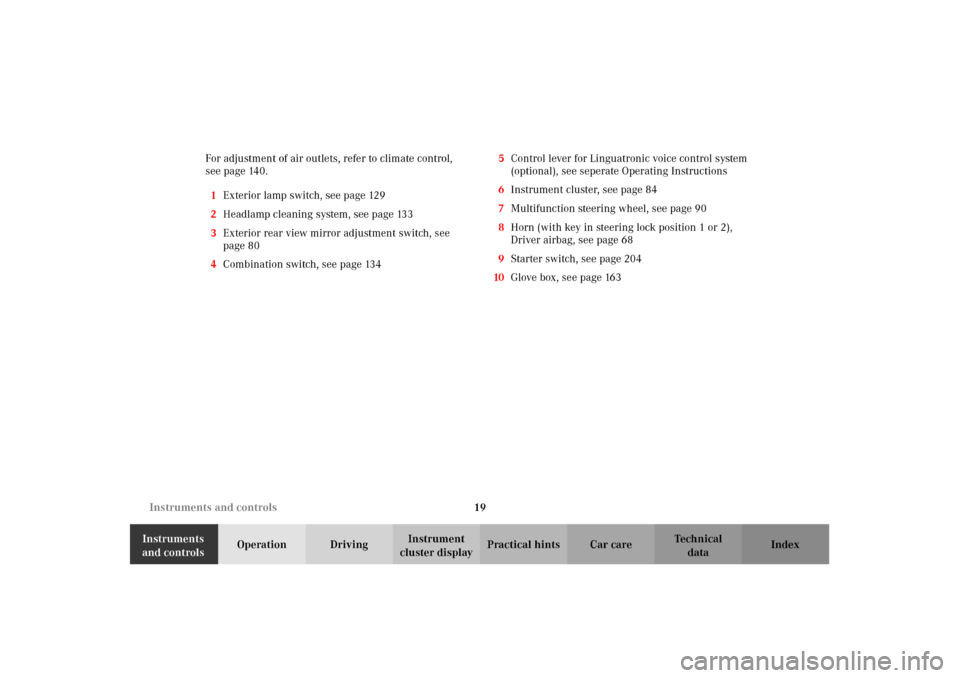
19 Instruments and controls
Te ch n i c a l
data Instruments
and controlsOperation DrivingInstrument
cluster displayPractical hints Car care Index For adjustment of air outlets, refer to climate control,
see page 140.
1Exterior lamp switch, see page 129
2Headlamp cleaning system, see page 133
3Exterior rear view mirror adjustment switch, see
page 80
4Combination switch, see page 1345Control lever for Linguatronic voice control system
(optional), see seperate Operating Instructions
6Instrument cluster, see page 84
7Multifunction steering wheel, see page 90
8Horn (with key in steering lock position 1 or 2),
Driver airbag, see page 68
9Starter switch, see page 204
10Glove box, see page 163
J_G463.book Seite 19 Mittwoch, 19. September 2001 8:06 08
Page 24 of 385
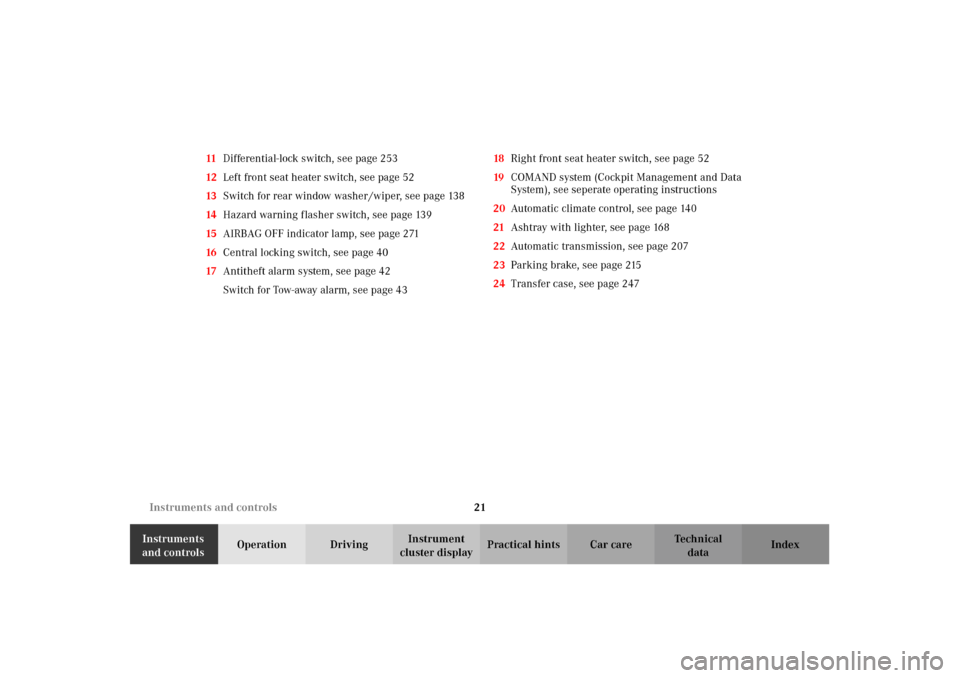
21 Instruments and controls
Te ch n i c a l
data Instruments
and controlsOperation DrivingInstrument
cluster displayPractical hints Car care Index 11Differential-lock switch, see page 253
12Left front seat heater switch, see page 52
13Switch for rear window washer /wiper, see page 138
14Hazard warning flasher switch, see page 139
15AIRBAG OFF indicator lamp, see page 271
16Central locking switch, see page 40
17Antitheft alarm system, see page 42
Switch for Tow-away alarm, see page 4318Right front seat heater switch, see page 52
19COMAND system (Cockpit Management and Data
System), see seperate operating instructions
20Automatic climate control, see page 140
21Ashtray with lighter, see page 168
22Automatic transmission, see page 207
23Parking brake, see page 215
24Transfer case, see page 247
J_G463.book Seite 21 Mittwoch, 19. September 2001 8:06 08
Page 27 of 385
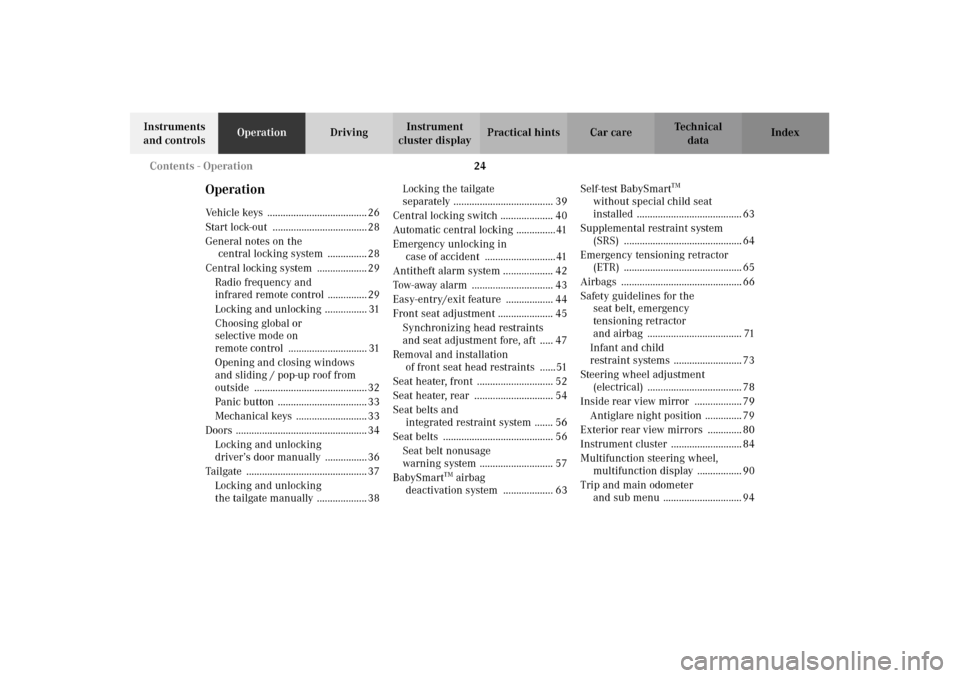
24 Contents - Operation
Te ch n i c a l
data Instruments
and controlsOperationDrivingInstrument
cluster displayPractical hints Car care Index
OperationVehicle keys ...................................... 26
Start lock-out .................................... 28
General notes on the
central locking system ............... 28
Central locking system ................... 29
Radio frequency and
infrared remote control ............... 29
Locking and unlocking ................ 31
Choosing global or
selective mode on
remote control .............................. 31
Opening and closing windows
and sliding / pop-up roof from
outside ........................................... 32
Panic button .................................. 33
Mechanical keys ........................... 33
Doors .................................................. 34
Locking and unlocking
driver’s door manually ................ 36
Tailgate .............................................. 37
Locking and unlocking
the tailgate manually ................... 38Locking the tailgate
separately ...................................... 39
Central locking switch .................... 40
Automatic central locking ............... 41
Emergency unlocking in
case of accident ........................... 41
Antitheft alarm system ................... 42
Tow-away alarm ............................... 43
Easy-entry/exit feature .................. 44
Front seat adjustment ..................... 45
Synchronizing head restraints
and seat adjustment fore, aft ..... 47
Removal and installation
of front seat head restraints ......51
Seat heater, front ............................. 52
Seat heater, rear .............................. 54
Seat belts and
integrated restraint system ....... 56
Seat belts .......................................... 56
Seat belt nonusage
warning system ............................ 57
BabySmart
TM airbag
deactivation system ................... 63Self-test BabySmart
TM
without special child seat
installed ........................................ 63
Supplemental restraint system
(SRS) ............................................. 64
Emergency tensioning retractor
(ETR) ............................................. 65
Airbags .............................................. 66
Safety guidelines for the
seat belt, emergency
tensioning retractor
and airbag .................................... 71
Infant and child
restraint systems .......................... 73
Steering wheel adjustment
(electrical) .................................... 78
Inside rear view mirror .................. 79
Antiglare night position .............. 79
Exterior rear view mirrors ............. 80
Instrument cluster ........................... 84
Multifunction steering wheel,
multifunction display ................. 90
Trip and main odometer
and sub menu .............................. 94
J_G463.book Seite 24 Mittwoch, 19. September 2001 8:06 08
Page 44 of 385
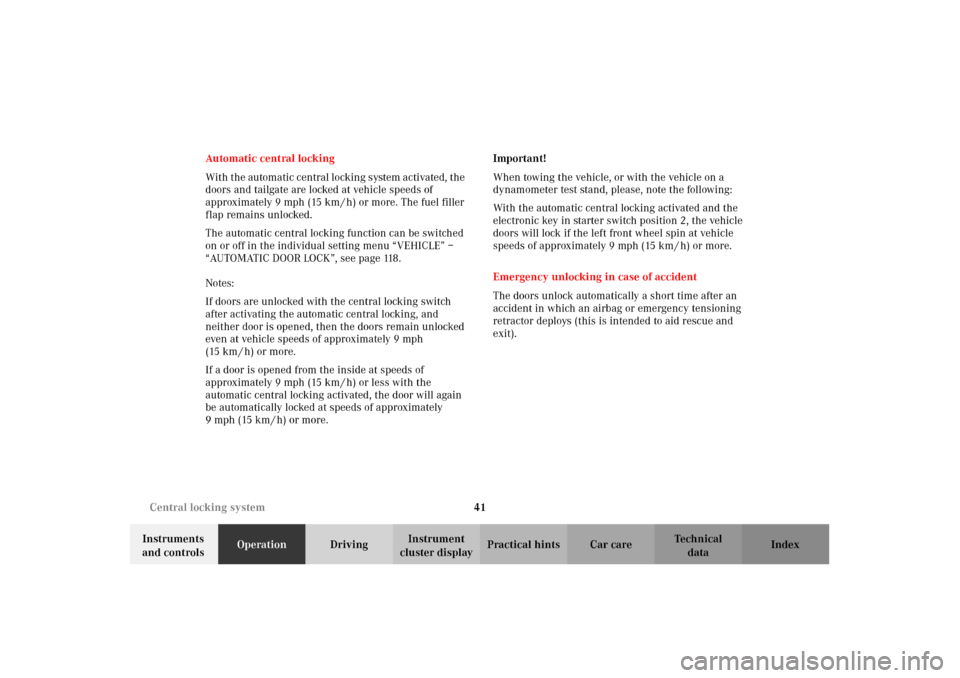
41 Central locking system
Te ch n i c a l
data Instruments
and controlsOperationDrivingInstrument
cluster displayPractical hints Car care Index Automatic central locking
Wit h t he autom atic c entral lockin g s ystem ac tivate d, t he
doors and tailgate are locked at vehicle speeds of
approximately 9 mph (15 km / h) or more. The fuel filler
flap remains unlocked.
The automatic central locking function can be switched
on or off in the individual setting menu “VEHICLE” –
“AUTOMATIC DOOR LOCK”, see page 118.
Notes:
If doors are unlocked with the central locking switch
after activating the automatic central locking, and
neither door is opened, then the doors remain unlocked
even at vehicle speeds of approximately 9 mph
(15 km / h) or more.
If a door is opened from the inside at speeds of
approximately 9 mph (15 km / h) or less with the
automatic central locking activated, the door will again
be automatically locked at speeds of approximately
9 mph (15 km / h) or more.Important!
When towing the vehicle, or with the vehicle on a
dynamometer test stand, please, note the following:
With the automatic central locking activated and the
electronic key in starter switch position 2, the vehicle
doors will lock if the left front wheel spin at vehicle
speeds of approximately 9 mph (15 km / h) or more.
Emergency unlocking in case of accident
The doors unlock automatically a short time after an
accident in which an airbag or emergency tensioning
retractor deploys (this is intended to aid rescue and
exit).
J_G463.book Seite 41 Mittwoch, 19. September 2001 8:06 08
Page 53 of 385
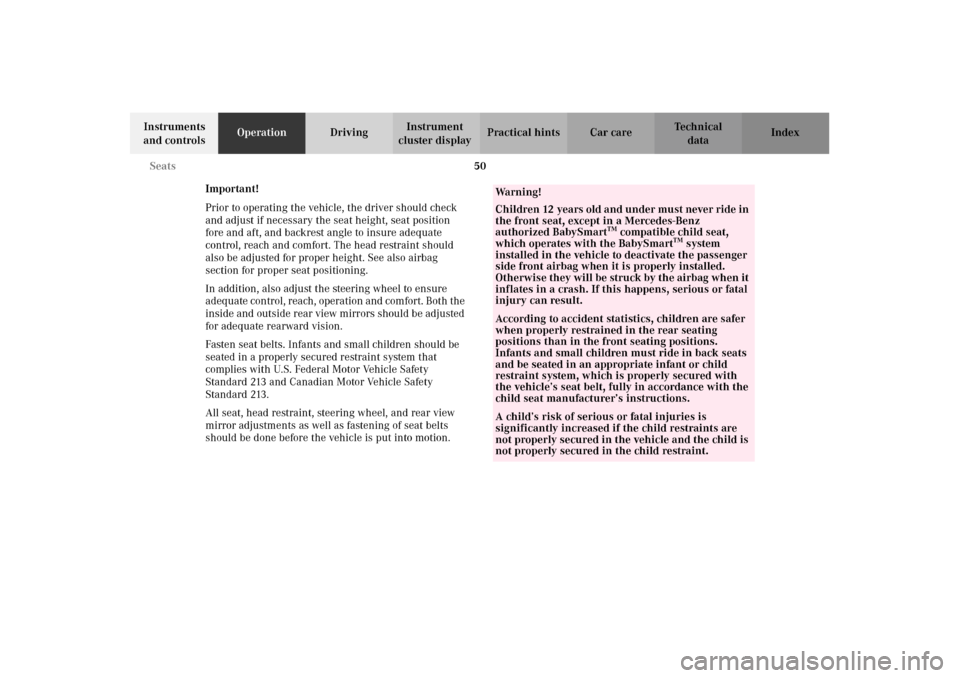
50 Seats
Te ch n i c a l
data Instruments
and controlsOperationDrivingInstrument
cluster displayPractical hints Car care Index
Important!
Prior to operating the vehicle, the driver should check
and adjust if necessary the seat height, seat position
fore and aft, and backrest angle to insure adequate
control, reach and comfort. The head restraint should
also be adjusted for proper height. See also airbag
section for proper seat positioning.
In addition, also adjust the steering wheel to ensure
ad eq uate con tr ol, r each, operation and com fort. B ot h the
inside and outside rear view mirrors should be adjusted
for adequate rearward vision.
Fasten seat belts. Infants and small children should be
seated in a properly secured restraint system that
complies with U.S. Federal Motor Vehicle Safety
Standard 213 and Canadian Motor Vehicle Safety
Standard 213.
All seat, head restraint, steering wheel, and rear view
mirror adjustments as well as fastening of seat belts
should be done before the vehicle is put into motion.
Wa r n i n g !
Children 12 years old and under must never ride in
the front seat, except in a Mercedes-Benz
authorized BabySmart
TM compatible child seat,
which operates with the BabySmart
TM system
installed in the vehicle to deactivate the passenger
side front airbag when it is properly installed.
Otherwise they will be struck by the airbag when it
inflates in a crash. If this happens, serious or fatal
injury can result.
According to accident statistics, children are safer
when properly restrained in the rear seating
positions than in the front seating positions.
Infants and small children must ride in back seats
and be seated in an appropriate infant or child
restraint system, which is properly secured with
the vehicle’s seat belt, fully in accordance with the
child seat manufacturer’s instructions.A child’s risk of serious or fatal injuries is
significantly increased if the child restraints are
not properly secured in the vehicle and the child is
not properly secured in the child restraint.
J_G463.book Seite 50 Mittwoch, 19. September 2001 8:06 08
Page 59 of 385
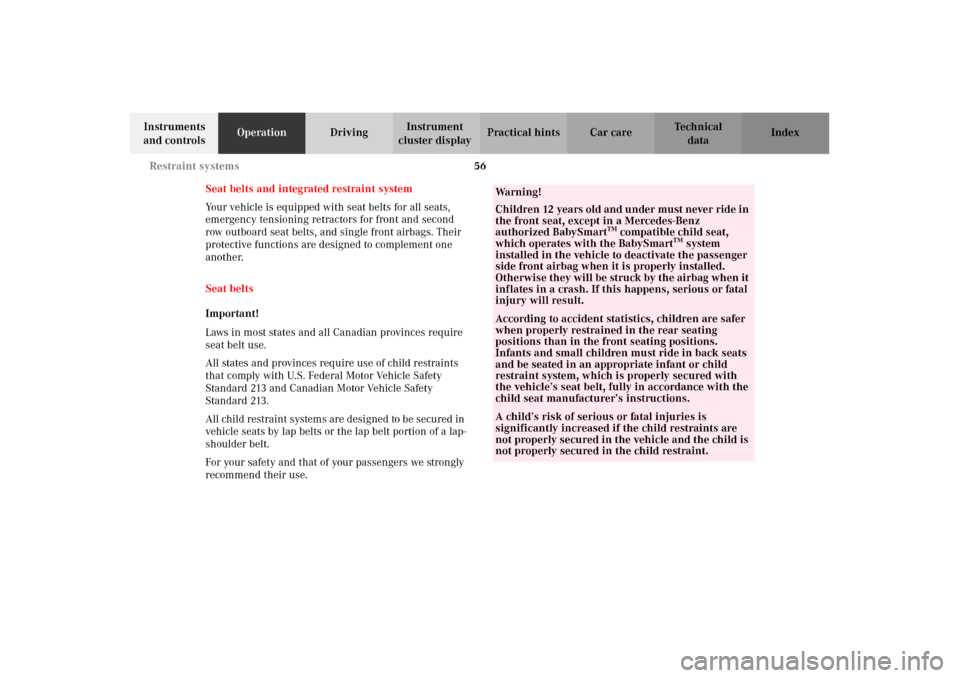
56 Restraint systems
Te ch n i c a l
data Instruments
and controlsOperationDrivingInstrument
cluster displayPractical hints Car care Index
Seat belts and integrated restraint system
Your vehicle is equipped with seat belts for all seats,
emergency tensioning retractors for front and second
row outboard seat belts, and single front airbags. Their
protective functions are designed to complement one
another.
Seat belts
Important!
Laws in most states and all Canadian provinces require
seat belt use.
All states and provinces require use of child restraints
that comply with U.S. Federal Motor Vehicle Safety
Standard 213 and Canadian Motor Vehicle Safety
Standard 213.
All child restraint systems are designed to be secured in
vehicle seats by lap belts or the lap belt portion of a lap-
shoulder belt.
For your safety and that of your passengers we strongly
recommend their use.
Wa r n i n g !
Children 12 years old and under must never ride in
the front seat, except in a Mercedes-Benz
authorized BabySmart
TM compatible child seat,
which operates with the BabySmart
TM system
installed in the vehicle to deactivate the passenger
side front airbag when it is properly installed.
Otherwise they will be struck by the airbag when it
inflates in a crash. If this happens, serious or fatal
injury will result.
According to accident statistics, children are safer
when properly restrained in the rear seating
positions than in the front seating positions.
Infants and small children must ride in back seats
and be seated in an appropriate infant or child
restraint system, which is properly secured with
the vehicle’s seat belt, fully in accordance with the
child seat manufacturer’s instructions.A child’s risk of serious or fatal injuries is
significantly increased if the child restraints are
not properly secured in the vehicle and the child is
not properly secured in the child restraint.
J_G463.book Seite 56 Mittwoch, 19. September 2001 8:06 08
Page 63 of 385
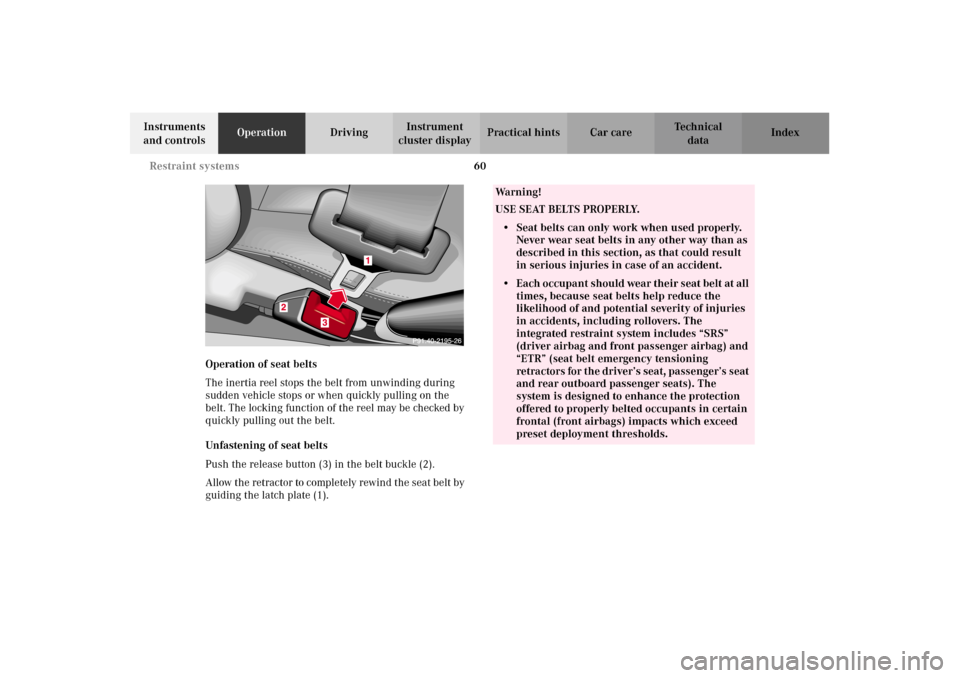
60 Restraint systems
Te ch n i c a l
data Instruments
and controlsOperationDrivingInstrument
cluster displayPractical hints Car care Index
Operation of seat belts
The inertia reel stops the belt from unwinding during
sudden vehicle stops or when quickly pulling on the
belt. The locking function of the reel may be checked by
quickly pulling out the belt.
Unfastening of seat belts
Push the release button (3) in the belt buckle (2).
Allow the retractor to completely rewind the seat belt by
guiding the latch plate (1).
Wa r n i n g !
USE SEAT BELTS PROPERLY.• Seat belts can only work when used properly.
Never wear seat belts in any other way than as
described in this section, as that could result
in serious injuries in case of an accident.• Each occupant should wear their seat belt at all
times, because seat belts help reduce the
likelihood of and potential severity of injuries
in accidents, including rollovers. The
integrated restraint system includes “SRS”
(driver airbag and front passenger airbag) and
“ETR” (seat belt emergency tensioning
retractors for the driver’s seat, passenger’s seat
and rear outboard passenger seats). The
system is designed to enhance the protection
offered to properly belted occupants in certain
frontal (front airbags) impacts which exceed
preset deployment thresholds.
J_G463.book Seite 60 Mittwoch, 19. September 2001 8:06 08
Page 65 of 385
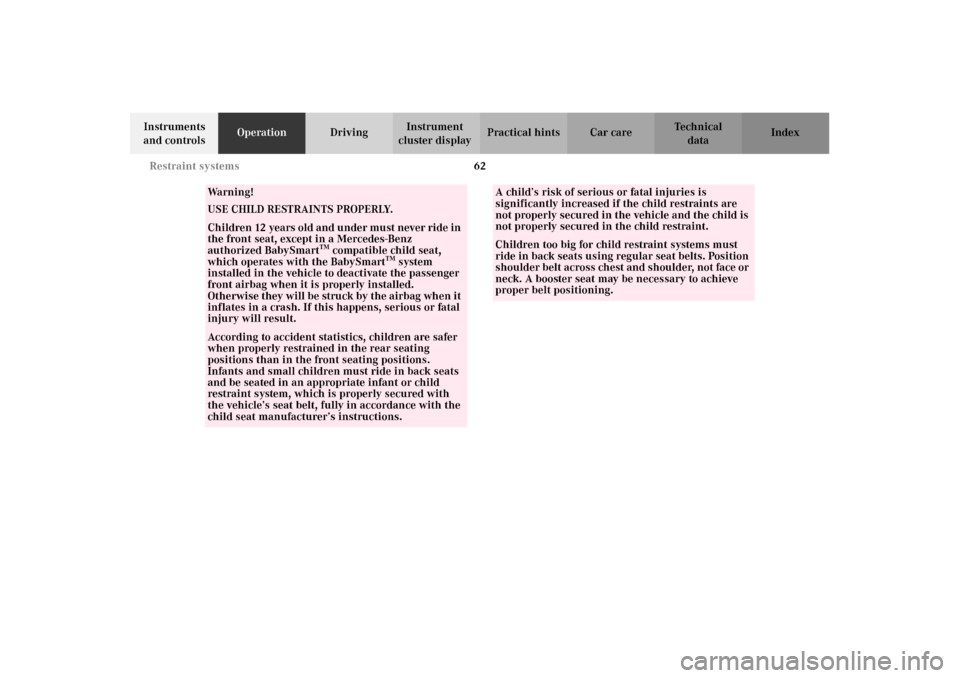
62 Restraint systems
Te ch n i c a l
data Instruments
and controlsOperationDrivingInstrument
cluster displayPractical hints Car care Index
Wa r n i n g !
USE CHILD RESTRAINTS PROPERLY.Children 12 years old and under must never ride in
the front seat, except in a Mercedes-Benz
authorized BabySmart
TM compatible child seat,
which operates with the BabySmart
TM system
installed in the vehicle to deactivate the passenger
front airbag when it is properly installed.
Otherwise they will be struck by the airbag when it
inflates in a crash. If this happens, serious or fatal
injury will result.
According to accident statistics, children are safer
when properly restrained in the rear seating
positions than in the front seating positions.
Infants and small children must ride in back seats
and be seated in an appropriate infant or child
restraint system, which is properly secured with
the vehicle’s seat belt, fully in accordance with the
child seat manufacturer’s instructions.
A child’s risk of serious or fatal injuries is
significantly increased if the child restraints are
not properly secured in the vehicle and the child is
not properly secured in the child restraint.Children too big for child restraint systems must
ride in back seats using regular seat belts. Position
shoulder belt across chest and shoulder, not face or
neck. A booster seat may be necessary to achieve
proper belt positioning.
J_G463.book Seite 62 Mittwoch, 19. September 2001 8:06 08